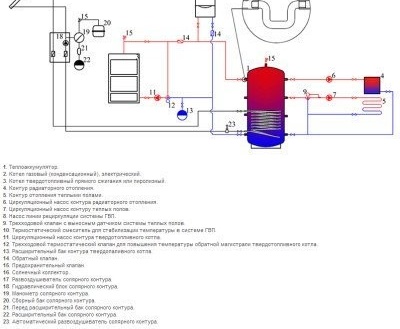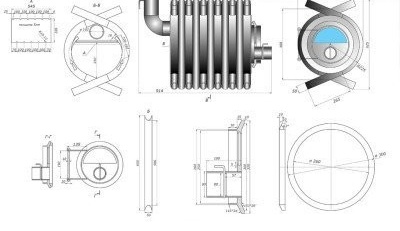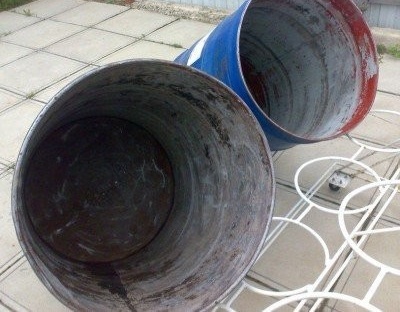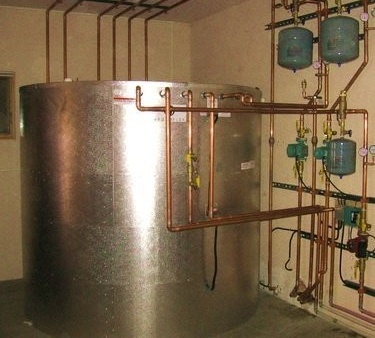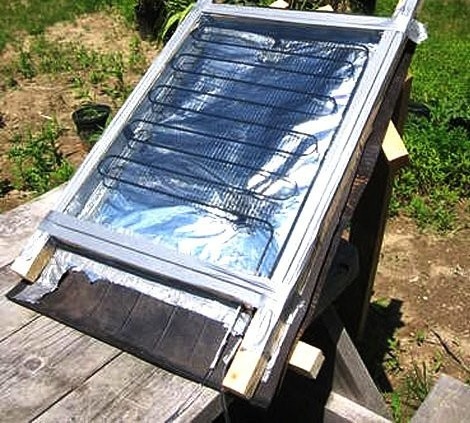Homemade heat accumulator
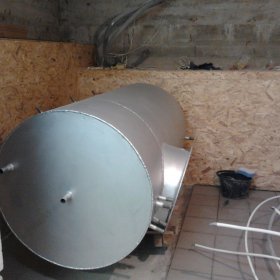
Solid fuel boilers are used for heating a house, because they are good as an alternative to gas, when there is no gas pipeline. But the efficiency of the solid fuel heating system is small. The situation can be corrected by installing a heat accumulator for the boiler.
Content
What is a heat accumulator?
We will tell about how to mount a heat accumulator in the following lines. However, at first, let's figure out what the described unit is for a solid fuel boiler. It's simple: this is a tank that saves the thermal energy of the boiler by collecting a certain amount of coolant. Installing such an element of the system solves several problems at once:
- increases heating efficiency - when the boiler equipment is completely stopped, this capacity replenishes the heating circuit with new doses of hot water,
- helps to save solid fuel - due to the presence of a heat accumulator in the system, the boiler can not be heated at night,
- extends the life of the entire system,
- prevents overheating of the heating circuit by taking on excess heat,
- allows the possibility of combining within themselves alternative energy sources, such as heating elements from solar panels.
In fact, the device of the described capacity is simple, if you wish, it is easy to make a heat accumulator exclusively with your own hands. Its design, in fact, includes such elements:
- capacity itself
- insulation of the entire body,
- inlet pipe-input
- output pipe-output
- internal coils.
The last element - the coil - is available mainly from purchased thermal batteries manufactured at the factory. That is, with such equipment, the coolant runs through numerous tubular coils inside a dry tank. And a heat accumulator that is easy to do with your own hands is just a hollow tank without coils. It is inside this tank that the collected coolant is stored. From these lines it is clear that there are two types of described aggregates:
- a container with coils inside, designed to save heat agent,
- the simplest heat accumulator in the form of a barrel for saving coolant.
Now the principle of operation of the storage unit for a solid fuel boiler should be understood. When the equipment is operating on hard fuels, the heat accumulator is replenished with hot water. When the boiler is turned off, this water feeds the heating system.
It is also easy to identify the advantages and disadvantages of the two types of saving devices indicated by us. If the heat accumulator is made with coils, then
- the heat preservation period increases,
- overall system efficiency increases
- however, such an assembly cannot be made at home.
If the heat accumulator is made without coils, according to the principle of storage of the coolant in the barrel, then
- it is very easy to make with your own hands, it is enough to have a minimum of funds and a suitable capacity,
- but it has little efficiency.
Next, we will consider how to make such a heat accumulator for a solid fuel boiler from a simple metal cylinder.
How to make a heat accumulator for a solid fuel boiler from a barrel
First you need to calculate the volume of the required capacity and make a drawing. In the drawing, you need to depict a standard barrel, which includes two pipelines. One of them transports the heat carrier from the boiler heat exchanger, and the second transfers hot water to the heating radiators. It remains only to calculate the dimensions of the barrel, or rather, its volume. Knowing the volume, it is easy to determine the diameter and height from the reference data.
If you need to calculate the volume of the tank, knowing the height and one of the following parameters: radius, diameter or area of the base, then it is most convenient to use a calculator that calculates online.
Let's start the calculation. Suppose our solid fuel heat generator is completely inactive at night for 4 hours (after cooling down), and the area of our small country house is 30 square meters. m. Therefore, the barrel should give about one tenth of the area per hour - 3 kW. Total 12 kW per night. In this case, the temperature difference of the barrel and heating will take a maximum of 40 degrees (say, if the water in the tank is heated to 90, then in the radiators - at least to 50).
According to the school physics course, m = Q / Ct, where
- Q - all thermal energy, we have 12 kW,
- C is the specific heat of the agent, that is, water, equal to 0.0012 kW / kg x g. Celsius
- t is the temperature difference.
We get according to this formula: m = 12 / 0.0012x40 = 250 kg. Thus, a water volume of 250 liters can be assumed. It turns out that as a heat accumulator for a solid fuel boiler under given conditions, a metal barrel of 250 liters is suitable for us. The approximate dimensions of such a barrel are 600x900 mm. That is, the diameter is 0.6 m, and the height (length) is 0.9 m.
What you need to take
For the manufacturing process of our heat accumulator, it is necessary to prepare the following materials and tools.
- An ordinary metal barrel, you can buy it in a store,
- welding machine with mask and electrodes,
- electric tools such as "grinders" and grinding and cutting discs, drill and drill, metal bit.
- two standard steel pipes for heating, each with a thread on the end, usually 3/4 inch,
- mineral wool.
It is better to start the procedure with the assistance of an assistant. In addition, the drawing should already be ready.
DIY step-by-step manufacturing
- Previously, the barrel is carefully cleaned from the inside. This is necessary to avoid constant contamination of the coolant with rust and scale. Cleaning can be done with a grinder and grinding wheels.
- Next, you need to drill two holes - inlet and outlet, under the diameter of the supply pipes. To do this, first use a drill with a drill for metal, and then it is better to use a crown.
- Further, nozzles are carefully welded into the holes obtained for the inlet and outlet of the coolant, that is, heated water. On these pipes, threads must be threaded at the ends that are not welded. Later, through this thread, ball valves will be screwed in to fit into the common heating system.
- After that, the top cover is very carefully welded. All welds should be leakproof to prevent leaks.
- Finally, the heat accumulator is insulated from the outside with mineral wool, for this purpose the barrel is wrapped with mineral wool layers, and then these layers, which have wrapped the barrel, are carefully tightened with rings of metal fastening tape.
- It remains for us to mount the assembly into the system by means of ball valves. The heat accumulator should be located immediately after the boiler, and the level should be higher than the radiators, so that the heat agent replenishes them well from our tank.
This is important to know! Do not use a plastic barrel. She is not able to withstand the working temperature of a thermal agent, reaching 90 degrees Celsius. The walls of such a barrel during operation in the system simply begin to melt. An exception may be plastic containers, on which the manufacturer indicates the maximum temperature of the contents above 90 degrees. But in this case, you still need to decide how to attach the pipes.
Some more comments
So we made a simple heat accumulator for a small heating system. As a result, a few more important points. For our example, the required barrel volume was 250 liters. However, when the house is large, a much larger drive may be needed. In this case, it would be better to weld a cubic box. In addition, it is easier to insulate with special materials.
Some craftsmen use for this option a standard, so-called European, cube with a volume of 1000 liters. It is sold in many stores. But here you need to remember that it is plastic. As a rule, the maximum water temperature that the Eurocube can withstand is 70 degrees Celsius, unless otherwise indicated in the marking. So using this tank in a heating system is simply dangerous.
And more about the insulation. Polyfoam is an ideal option for a cubic metal box. The fact is that this insulation is easy to glue to the walls. Minvata is more suitable for an ordinary barrel, but you will need to figure out how to fix it, because the method with metal rings that we described is not required.
Video: useful information about the unit
So, we have described a simple way to create a storage tank for heating. In the process of self-production of such an assembly, independent adjustments to the described technology are possible.
